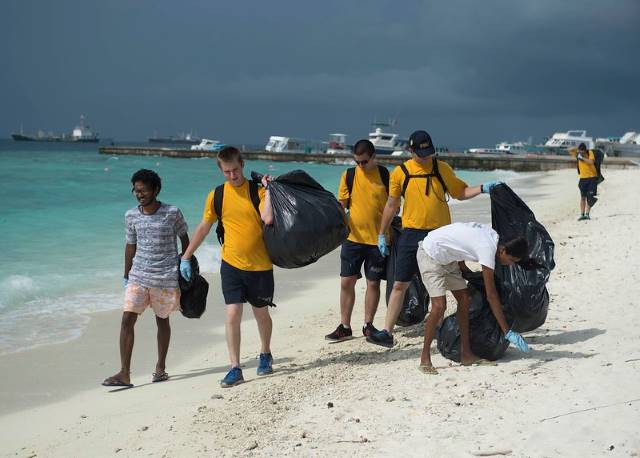Clean Waters: The Ocean Cleanup Organization
 Seven years ago, The Ocean Cleanup organization launched as a Dutch nonprofit dedicated to eliminating the Great Pacific Garbage Patch using autonomous, solar-powered cleaning systems. Now, as part of a new initiative, the organization is rolling out barges in major rivers as an upstream solution to global, prolific marine debris.
Seven years ago, The Ocean Cleanup organization launched as a Dutch nonprofit dedicated to eliminating the Great Pacific Garbage Patch using autonomous, solar-powered cleaning systems. Now, as part of a new initiative, the organization is rolling out barges in major rivers as an upstream solution to global, prolific marine debris.
Marine Plastic Pollution
At least eight tons of marine plastic enter the oceans each year, where a majority floats on the surface before breaking down into non-biodegradable microplastics. Around 80% of marine debris flows through rivers before reaching the ocean. Because a handful of countries are responsible for a majority of marine debris, cleaning just 10 major polluting rivers of waste would stop a significant amount of debris from ever reaching the ocean.
The Ocean Cleanup Organization
Based in the Netherlands and led by a 26-year-old entrepreneur, Boyan Slat, The Ocean Cleanup organization has plans that include fitting the world’s 1,000 most polluting rivers with waste removal systems over the next five years. The organization’s research indicates that 1,000 specific rivers are responsible for 80% of the pollution.
The Interceptor Concept
Solar powers the waste removal systems, and they are scalable and largely autonomous. Each one uses barriers to direct waste along the river to a floating “interceptor” barge, which loads waste with a conveyor belt into containers that local municipalities can then dispose of. Individual interceptors can collect 50,000 kilograms of waste each day, though “in optimal conditions up to double this amount can be achieved.”
The interceptor concept, designed in 2015, was first utilized in the Cengkareng Drain, Indonesia, where it has remained. The Ocean Cleanup has since partnered with local governments to deploy three more interceptors in Malaysia, Jamaica and the Dominican Republic. By placing each one downstream from the last major source point in a river, they manage to fill all containers every few days, though they sometimes fill up in only a few hours.
Impact of Microplastics
Marine plastics’ widespread and harmful effects on marine life are well-documented, with hundreds of species ingesting, suffocating and entangling themselves in plastics. The global impact of aquatic microplastics, by contrast, is an emerging field of study. Appearing in tap water, beer and salt, they have appeared in water samples taken from every ocean. In 2019, the World Health Organization called for more research into microplastics and a drastic reduction in plastic pollution.
An environmental health report published in 2018 stressed the risk of consuming microplastics in seafood. “Because microplastics are associated with chemicals from manufacturing that sorb from the surrounding environment,” the report finds, “there is concern regarding physical and chemical toxicity.”
Consequences of Marine Plastic Pollution
While microplastics are under-researched, larger marine waste has concrete impacts on water-adjacent communities because marine plastics kill wildlife and disrupt local ecosystems, harming livelihoods and impeding tourism. More pressing, severely polluted waterways exacerbate poverty and poverty-related issues, especially among young children. According to experts at UNICEF, children living in South Asian slums frequently play in rivers and shores contaminated with waste, excrement and agricultural runoff. Since many lack access to clean water and sanitation facilities, this makes poor water-adjacent communities hotbeds for preventable illnesses.
The Ocean Cleanup found that marine plastic is responsible for between $6 billion and $19 billion of economic costs annually. These costs “stem from its impact on tourism, fisheries and aquaculture, and (governmental) cleanups,” and do not even account for the disability-adjusted life years (DALYs) lost because of its public health impact.
Hopes for the Future
The Ocean Cleanup organization hopes to significantly reduce plastic pollution in oceans. Once fully implemented, the waste removal systems aim to reduce the Great Pacific Garbage Patch by 50% every five years. The organization’s latest endeavor is a line of sunglasses made from plastic removed from the Great Pacific Garbage Patch. With all proceeds going toward expanding cleanup efforts, this is the most stylish way an ordinary person can contribute to a greater cause.
– Skye Jacobs
Photo: Flickr
